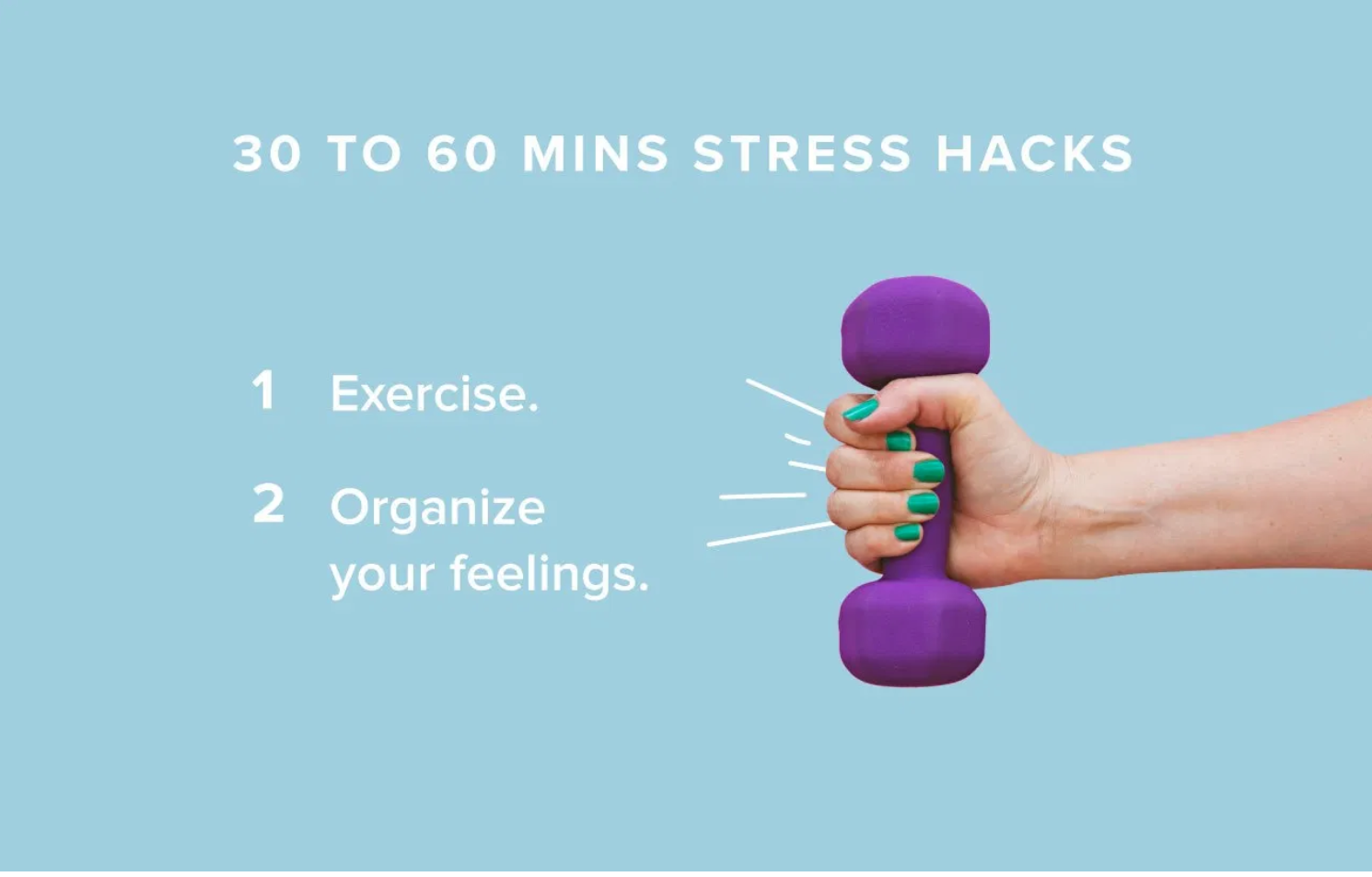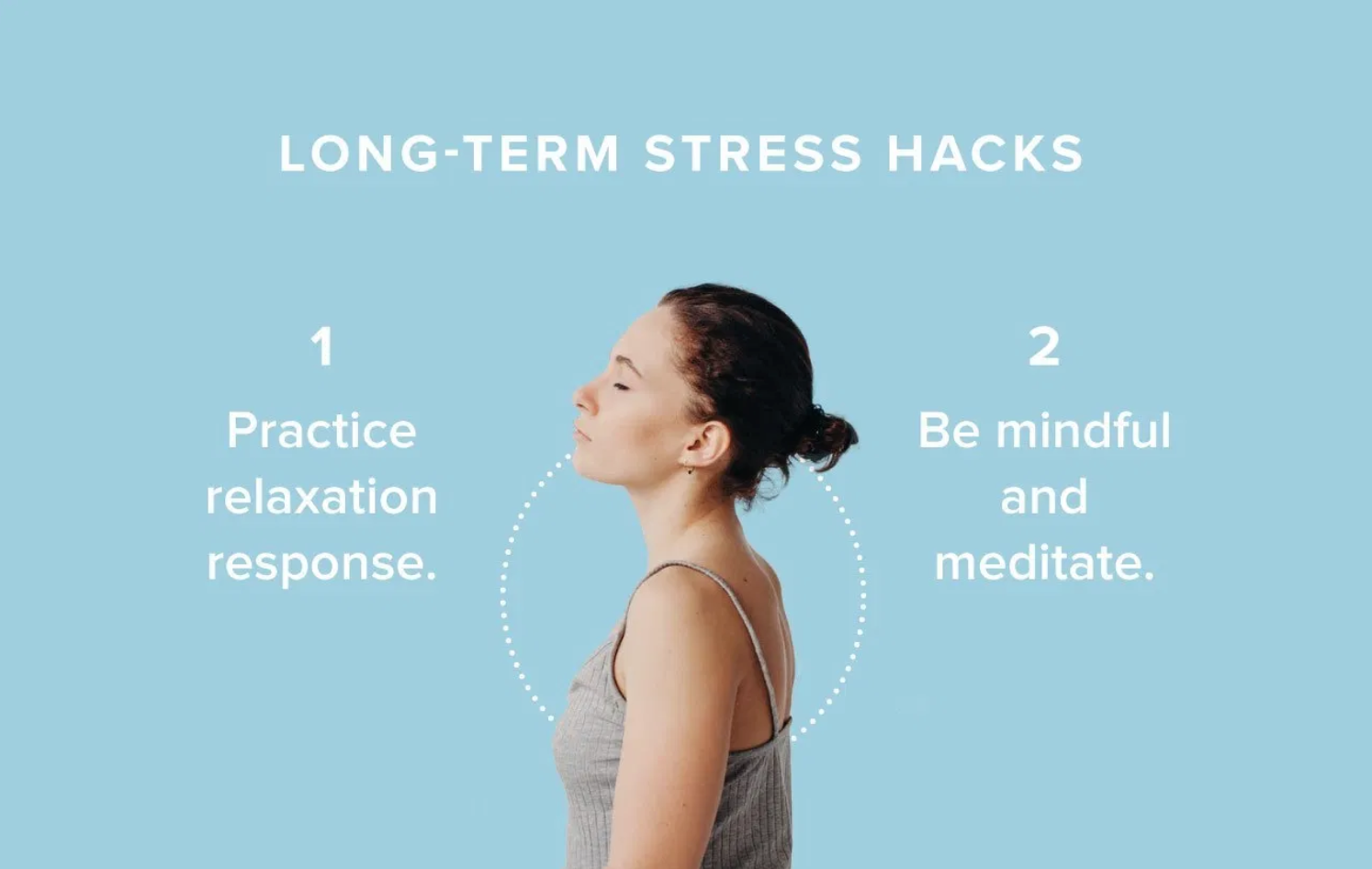You can’t eliminate stress, but you can learn how to mellow out.

You know the feeling. Your ears grow hot. Your heart beats against your brain. All saliva evaporates from your mouth. You can’t focus. You can’t swallow.
That’s your body on stress.
Big concerns like debt or a family emergency can up the pressure. But so can smaller stuff like a work project snafu, a fender bender, or even a snappy text from your roomie. And sometimes all the things happen at once, making you feel like you’re under attack and sending you into a tizzy.
Unfortunately, we can’t actually stress-proof ourselves.
“Stress is a healthy response,” explains Lauren Rigney, a Manhattan-based mental health counselor, and coach. “It alerts us to things we may need to pay more attention to. It can save us during times of danger.”
But with DIY stress hacks, we can learn to control our physical and mental reactions and lessen the impact that strain and worry have on our lives.
Do this to feel better now

You can make stressful situations less challenging by convincing your “flight or fight” system to bugger off and reactivating your “rest and digest” system.
Even if the stressful event is still unfolding, like you’re mid-argument with your partner, you can find focus and calm.
“We can control the panic before it fully sets in if we know the warning signs,” Rigney says. “While there are common ones to look out for, like shortness of breath and faster pulse, it can vary between people.”
At the first sign of your fight or flight response, try to mellow out with these techniques:
Diaphragmatic breathing involves taking a slow, long breath, letting the diaphragm expand the belly on the inhale, and then exhaling completely before repeating the process.
A recent study links controlled breath to calmer states of mind.
Progressive muscle relaxation (PMR) involves tensing muscle groups one at a time in a specific order as you breathe in and then releasing as you exhale. Clenching fists is one example.
A recent study demonstrated PMR’s potential to lower heart rate and blood pressure. You can learn full-body PMR by following a scripted guide, but even just a few minutes of focusing on one area of the body can make a difference.
One-minute PMR
- Inhale and wrinkle the forehead. Hold for 5 seconds. Exhale and release.
- Inhale, close your eyes tightly, and scrunch your cheeks. Hold for 5 seconds. Exhale and release.
- Inhale, clench your jaw, and stretch mouth to a grin. Hold for 5 seconds. Exhale and release.
- Inhale and squeeze your lips together. Hold for 5 seconds. Exhale and release.
- Inhale and puff the air into your cheeks. Hold for 5 seconds. Exhale and release.
- Repeat a few times, if necessary.
Why do these quick techniques work?
To understand how diaphragmatic breathing and PMR work, you’ll need to know how stress kicks your bod into protection mode.
Our bodies get all revved up when we’re stressed because of involuntary reactions stemming from our autonomic nervous systems (ANS). The ANS has two subdivisions (PNS and SNS) that sometimes act in opposition. They’re kind of like siblings who get along well, but also compete with each other.
| Parasympathetic nervous system (PNS) |
Sympathetic nervous system (SNS) |
| slows heart rate | speeds heart rate |
| helps with digestion | halts digestion processes |
| tackles metabolism | increases muscle contraction |
| dilates blood vessels | opens airways |
| brings on relaxation | releases adrenaline |
| increases glucose delivery |
The [SNS] response triggers our adrenal glands to produce more cortisol and adrenaline,” Rigney says. “The increased production of these hormones causes faster heart rate, faster breathing, constriction of blood vessels, and increased glucose release into our bloodstream.”
SNS VS. PNS The sympathetic nervous system (SNS) activates our “fight or flight” response. The parasympathetic nervous system (PNS), also called the “rest and digest” system, activates digestion and metabolism when we’re just chilling. It also helps us do the actual relaxing by bringing down our heart rate.
During stress, your ‘fight or flight’ system likes to be the center of attention
“Your SNS shuts down the other systems you don’t need for immediate survival. That’s why you might suddenly feel queasy when you get back from lunch and your boss asks you for an impromptu meeting. That burrito you noshed is just sitting in your stomach, no longer being digested.
It’s also why your mouth might go dry just as you’re about to give a presentation. Those salivary glands have been given the kill switch.
In a fleeting moment of stress, your SNS springs into action and takes over, Rigney explains. But then your body quickly realizes the threat isn’t real and goes back to a calmer state with the PNS once again in charge.
But if the threat or challenge remains, like you’re in the middle of an important exam, your SNS might keep you in a panic, making it hard to ponder the multiple-choice questions. Here’s where some diaphragmatic breathing can help. And no has to know you’re even doing it.
“Spending a few minutes mindfully breathing alerts the SNS that the external stressor is no longer an issue and that you have taken over control of your body,” Rigney explains. “When your breathing slows, your heart responds, and your brain will receive messages that everything is okay.”
Take a break from the hustle and bustle

Those 5-minute stress destroyers are great for situations when you can’t take a true time out. (You still have to breathe when you’re in traffic!) But intentionally fitting in bigger reprieves when possible can help provide a constructive reset.
If you have 30 to 60 minutes, try these options:
Exercise
If you’re prone to panic when stress sets in, exercise can help you cope.
On the immediate side, the effects of moderate activity can be felt in as little as five minutes. You’ve probably heard of the runner’s high or how exercise floods you with feel-good endorphins. But there’s more to that: The more often you sweat it out, the less reactive you’ll be, research shows.
When you get your heart rate up and begin to pant, you’re creating some of the same bodily reactions you might experience if faced with a stressor. This makes you more resilient to those involuntary stress responses.
Cognitive behavioral therapy (CBT)
CBT can help you reassess your to-do list and the feelings associated with it. If a continued accumulation of tasks and goals makes you feel like you’re failing at adulting, your stress responses might be the culprit.
“Our thoughts can drive our panic and grow it,” Rigney explains. She suggests doing some mindfulness breathing to calm yourself and then taking a fresh inventory.
“Go back to that list and trim it down or organize it,” she says. “Pick the top items that need to be completed and then break down the more complicated items into small, workable parts.”
Stave off stress by training your body to handle it

If there’s no sign of the stress stopping soon (such as work stress or a long-term situation), it might be time to rewire our brains for better coping by making stress-relief tactics part of our routines.
“If we experience chronic stress,” Rigney says, “our body continues to function at this heightened level and eventually believes this unhealthy state to be the way we are supposed to function.”
Not opening the valve on the pressure regularly, it turns out, has whole-body health consequences, from depression to heartburn.
To keep the worry beast at bay, make chill town a regular destination. “Long-term habits are essential for managing stress because they can keep chronic stress from developing and give you a baseline to return to when situational stress overwhelms you,” Rigney says.
Give these calming techniques a go:
Relaxation response (RR)
RR is a time-tested method you can use to reverse your stress response and even lessen it over time, but it may take a while to hone your happy place. The concept is to find a calming activity you can do daily.
Some people choose to focus on their breath while repeating a calming phrase for 20 minutes. But any repetitive activity works.
Try these RRs
- Swim laps.
- Go for a walk or run.
- Take a bike ride.
- Brush your pet.
- Knit or crochet.
- Do a series of yoga sun salutations.
- Fill in the page of an adult coloring book.
- Create art.
- Do woodworking.
- Play a musical instrument.
- Sing a song.
Mindfulness-based stress reduction (MBSR)
“I encourage my clients to do several mindful check-ins throughout the day — while you are home in the morning, starting your workday, at lunch, mid-afternoon, transitioning away from work and before bed,” Rigney says. “These check-ins can be 30 to 60 seconds long and allow you to reset your nervous system.”
MBSR can help you regulate your emotions, studies show. You can do an in-depth, formal practice using an app like Headspace or just take a few minutes to close your eyes and focus on the present.
Rigney recommends acknowledging your current emotional state and focusing on the air entering and leaving your lungs.
When to talk to a pro
DIY methods are great to have in your arsenal, but if you’re dealing with a major life change or loss or if the smaller stressors pile up to Everest heights, reach out to a mental health professional.
Talking through worries and triggers can provide immense relief, and a pro can help you customize stress-busting strategies that work for you.
Certainly, don’t stress over stress-relief options. If the techniques mentioned here don’t liberate you from panic and pressure, revise them to fit your specific needs or lifestyle.
“There is no exact formula for these habits,” Rigney reminds us. “Have a few in your toolbox. Different types of stress can need different types of coping skills. So play with it a bit.”
Originally published on Healthline.





